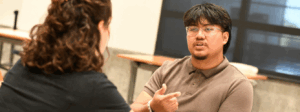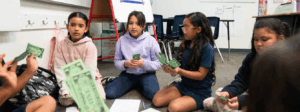Dr. Nikolai P. Vitti is the superintendent of Duval County Public Schools. Recently, he and his team overhauled his district’s curriculum in order to better align it to Florida’s college and career readiness standards. One of the big challenges facing school districts as they transition to new standards is that great teaching can only take place when teachers and students have access to the right content in the classroom. Under Dr. Vitti’s leadership, Duval has restructured the process for choosing curricular materials, to make sure the content in every classroom allows teachers and kids to tackle higher standards. We spoke to him about that process.
Why did you decide to tackle curriculum in a new way?
It started because we wanted to change the way we thought about human resources in our district. We brought in TNTP to provide us with a third party, objective, analytical review of our practices. You conducted an audit of how we look, from a systems point of view, at hiring our teachers, identifying high performing teachers, evaluation tools, and recruitment.
That initial analysis moved into other conversations and other points of interest related to teaching and professional development, which brought us to curriculum. We looked more nationally, more globally, at the type of curriculum we used and decided to do everything we could to empower teachers and principals to use tools directly aligned to new standards and grounded in a research‑based approach.
What are your biggest curriculum priorities in the next few years?
Identify highly aligned curriculums across all grades and subjects. That's critical. If a curriculum is not aligned to standards, you're putting teachers and students at a disadvantage to meet the expectations of those standards.
The process of adopting a new curriculum in K-5 literacy and math is tough work—our teachers, principals, and district staff have learned a lot. The big takeaway is that, often, the path of least resistance makes everyone feel comfortable, but if those materials aren’t aligned to the standards you’re trying to reach, it takes a lot of effort to supplement them with other curricular materials. Our priority is to identify materials that provide a clear pathway for teachers to teach at the rigor of the standards.
You’ve chosen to adopt, customize, and implement open educational resources, a move recently reinforced by the Department of Education. Why were you on the leading edge on this? What you have learned?
Districts rely on what they have traditionally done. For us to step out of that box was difficult because of our fear of the unknown. But we made a decision based on what we think is best for children and teachers. It was a decision based in part on looking for the most aligned curricula, but also, the issue of cost was relevant. If you're able to identify aligned curricula, and it's more expensive, it’s still the best solution for teachers and students. But if you find curricula that is aligned and less expensive, that not only benefits teachers and students, but also allows you to fund other priorities, including more support to help teachers use those new materials well in their classrooms. It's a win‑win.
Some argue decisions about curriculum and materials should rest at the school or teacher level. What are the benefits and challenges of taking a centralized approach and choosing those materials at the district level?
I think a core curriculum that's uniform across multiple schools is essential to ensure access to new standards are equitable. Regardless of ZIP code, students will be exposed to the right expectations at every subject and grade level, at least where math and reading is concerned. This also helps reduce problems with professional development: Without a uniform core curriculum, it’s challenging to provide resources to schools and identify what they’re struggling with.
The challenges lie in the perception that you're not acknowledging or respecting school‑based autonomy and decision‑making. Handling that isn’t easy, but one way to do it is to engage stakeholders in a collaborative, transparent, and diverse way. I believe you can create an adoption process that validates the needs of teachers and principals at varying schools. In Duval, we're large and diverse: We have schools that are urban, suburban, and rural. By selecting principals and teachers from each of these schools, and making them part of the adoption process, you allow everyone to feel that their voice is heard.
What have you learned about investing parents in curriculum choices? How are you thinking about this aspect of adoption and implementation moving forward?
Parents were involved in the selection of the curricular materials in K-5. They saw the analysis regarding how different curriculum options stacked up as far as alignment to standards. It was evident through that analysis which materials were superior, so they were on board. We plan to use the same approach moving forward.
Our challenge is one that all districts are facing at different degrees: New standards require students to apply, synthesize, and analyze information at an entirely different level. The work they’re doing in the classroom and the work they have to do at home is at a whole new level of rigor many parents didn't face in school.
As a result, there's a frustration among parents regarding, for instance, the use of different strategies in math—even if students will gain a deeper, theoretical, and conceptual understanding of mathematics as a result of those strategies. As a parent with three children in elementary school, I get it. My wife and I—we both have master's degrees and she was an elementary teacher—have to relearn concepts in math ourselves to help our kids at home because students are learning things in different, more thorough ways now. But my children understand elementary mathematics much better than I ever did at that age.
It is important to engage parents in the selection of materials by doing things like working with the PTA to assemble focus groups on possible adoptions, but districts also need to improve the tools they offer parents online once they adopt. Today's parent is more likely to feel comfortable with accessing resources online. Modules that allow parents to model how math is done through sample problems will allow them to model the process for their kids at the kitchen table.
If another district or superintendent came to you for advice on improving the quality of their materials, what would you suggest?
It helps to have a partner, a third party, come in with a completely different set of eyes and experiences. I find most adoption processes are rather connected to the status quo and a traditional way of selecting materials. If you're picking curriculum that is “easier to use,” you're not setting teachers and students up to succeed. Think outside of the box. Be very thorough in the analysis of what is offered. Be sure to use a tool that allows you to gain understanding of alignment.
Engage multiple stakeholders: Teachers, principals, assistant principals, district staff, and parents. Their buy-in is critical. We moved into this school year and our new curriculum with a high level of support from our teachers, principals, and district staff who participated in the process. Making big decisions in isolation would have set us up for failure. Instead, a difficult transition to a new set of curricula has been challenging but we are seeing a difference in what children are doing and learning in the classroom because of it. Each year will be easier as teachers, principals, parents, and students adopt to the new curriculum and standards.







